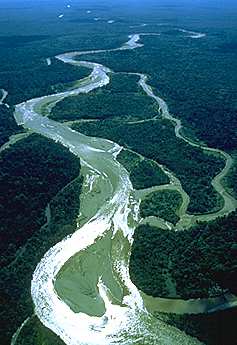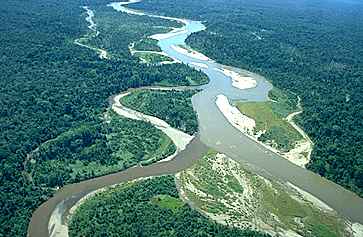New Guinea, an unknown world
New Guinea is the second largest island on our earth after
Greenland and posses probably the most biggest and originally wilderness.
These Island posses a total area of 771,900 square kilometers. Along 141.
Degree of Longitute New Guinea get divided in 1828. The eastern part is since
1975 the independent State of Papua New Guinea. The western part is since
1963 occupied by Indonesia. These "West Papua" part get the name
Irian Jaya. These name have been changed by Indonesian President Abdurrahman
Wahid (Gus Dur) into PAPUA on 01 of January 2000.
The whole island has more than 600 islands all around. New Guinea belonged
actually to the Pacific region and is constituent of Melanesia.
The origin of New Guinea
Approx. 30 million years ago the mountains arise at the island. Still until today the different tectonic discs in this region are in motion. This reflects itself in the many earthquakes in this region.
About 50,000 - 30,000 v.Chr. formed New Guinea and Australia a land mass. But around 10.000 v. Chr. this is changed depend on the raising sea level after the last ice age. The first provable settlements date themselves on approx. 24.000 v. Chr.
The landscape of New Guinea
It shaped by the large mountains which the island is pull through. Large valleys and steeply rising mountains are the typical picture in the high mountains of New Guinea. The biggest mountain are in the western part of the iasland. It´s the puncak Jaya with its 4,884 m. These are the highest mountain range between the Himalaya and the Andes. On the eastern part of New Guinea we have to name the 4509 m high Mt. Wilhelm. In the south of Papua (Irian Jaya) we can found the wide swampy areas of Asmat. To the north there are also many wide swampy areas. Especially we have to name the Mamberamo area. These will be the most biggest swampy area of this kind. In Papua New Guinea you can find some untypical landscapes for New Guinea. Especially in the southern part. This are the grasland savanne. To the north the landscape will be shaped by the big rivers like Fly and Digul. Also a hill landscape have to be pronaunced.
Rainforests & mountains
Sie teilen sich in verschiedene Zonen auf:
|
 |
|
You can found more exact definitions at the Flora page.
